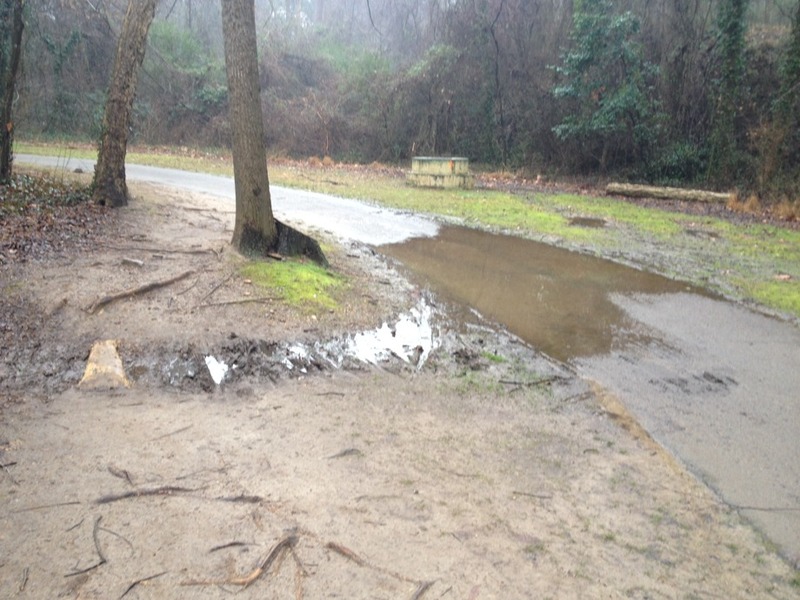Karin Singleton and her dog were enjoying a stroll on a Raleigh greenway when they reached an impasse one chilly January morning.
The Crabtree Valley resident noticed that rainwater and thick mud were blocking one of her favorite walking spots. But thanks to the city’s use of the software application SeeClickFix, Singleton was armed with a solution.
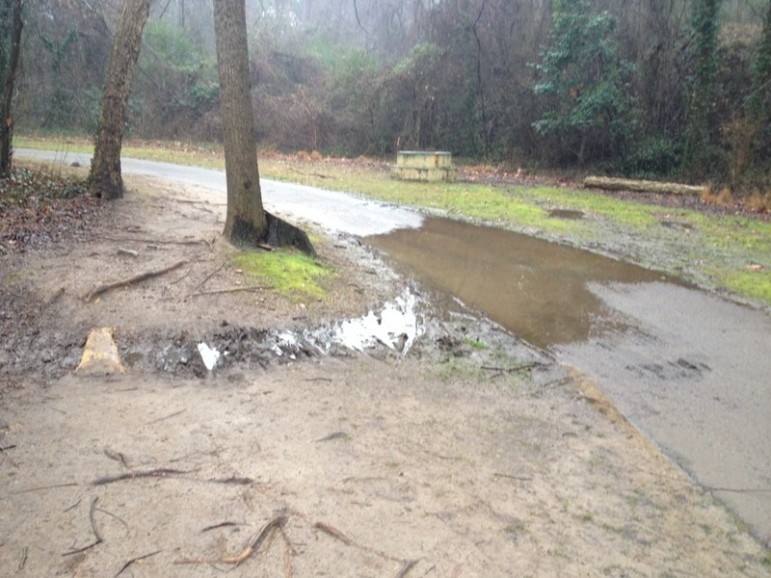
Karin Singleton
Heavy rains left a Raleigh green way impassable
Using her phone, she quickly snapped a picture and posted a complaint to the SeeClickFix website.
Singleton’s post triggered an automatic email sent to an employee within the City Manager’s Office. The recipient forwarded the complaint to the appropriate city department, in this case Raleigh Parks, Recreation and Cultural Resources.
Parks and Rec acknowledged the report via the website a day later. Two days after Singleton’s initial post, the city reported the problem was rectified.
Response Time May Vary
Not all problems submitted to SeeClickFix are addressed and resolved so quickly. An analysis conducted of data from 2013 shows that the longest time between a problem being reported and the city acknowledging it was 7 months.
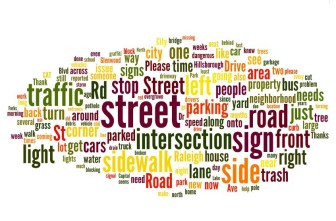
A WordCloud of common SeeClickFix complaints
However, the number of problems that took more than a month to be acknowledged is around 45; out of the 4,133 acknowledged complaints from 2013, this represents 1 percent of the total.
The average time to acknowledgment for 2013 was 2.25 days. When a complaint is acknowledged, it essentially means the city posted a response to indicate the appropriate department was notified.
Many of the problems reported are not city issues – around 160 complaints dealt with traffic signals, the maintenance of which has been contracted out by the city to Duke Energy.
These non-city problems – which include everything from complaints about bad drivers to the lack of a pay phone at the intersection of South Tarboro and East Martin Street – are still marked as acknowledged by the city and eventually marked closed.
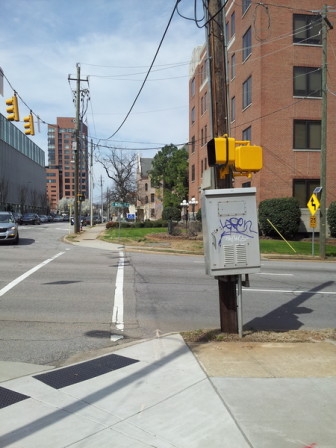
Mark Turner
Graffiti, seen here on a utility box on West Jones Street, is a frequent source of SeeClickFix complaints
A survey of the complaint summaries from 2013 shows potholes to be the most common issue, with around 250 mentions. Other frequent complaints include 122 for graffiti, 120 for stop signs, and 40 dealing with the homeless population.
Of the 4,619 total complaints lodged, 486 were not acknowledged, although these were mostly due to users closing the complaint before the city addressed it. Of the 4,133 acknowledged complaints, 576 were not closed. 39 of these, however, do have reported closing times – although the date listed is often prior to the date the complaint was filed, a likely computer error.
It should be noted that the data collected and analyzed by the Record does not include information on how, or if, problems were resolved – only if they were acknowledged or closed.
One problem that has been marked as closed, for example, was summarized as “Aggressive driver… in burgundy Honda” which was reported on May 9, 2013, was acknowledged after two hours and closed after four days.
A Recent Backlog
A rise in complaints this year culminated in September when many users began noticing an extended delay in getting their problems addressed.
In response, the city issued the following statement:
“The City of Raleigh appreciates your taking the time and effort to report your concerns on See, Click, Fix. While City staff makes every effort to promptly respond to every reported concern, the lack of dedicated resources to monitor and respond to See, Click, Fix has resulted in delayed responses over the last several weeks.
“Being responsive to our residents’ concerns is essential to the City’s mission. Please know that the City of Raleigh staff is attempting to respond quickly and completely to posted concerns. Your patience is greatly appreciated.”
Even when there is no backlog, Louis Buonpane, Chief of Staff of the Raleigh City Manager’s Office, noted that residents should not rely on SeeClickFix as a one-stop shop for solving all municipal problems.
“It’s merely a communication tool, a reporting tool,” said Buonpane. “It’s not a work-order system.”
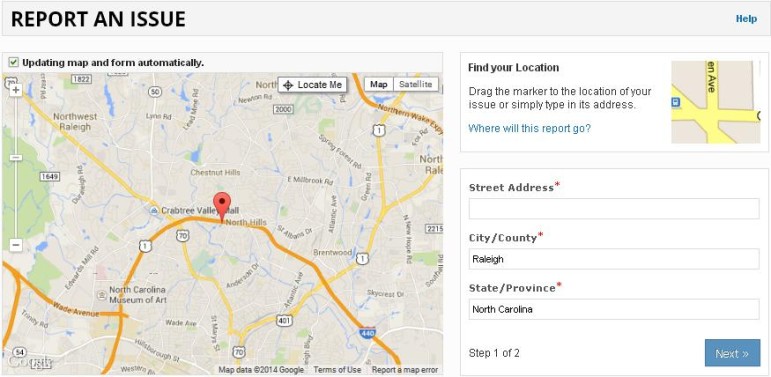
Users can report any issue they like on the SeeClickFix website
Buonpane said limitations in the software, and the wide variety of reports, make allocating resources difficult in certain situations. Some reports are not the city’s responsibility, he said, while other reports aren’t necessarily an appropriate use of the website, he pointed out.
“Sometimes it’s used inappropriately to report emergencies or a barking dog,” he said. “In its most basic sense, it’s a social media tool. It’s got its limitations. It’s not a sophisticated work-order system.”
Bringing SeeClickFix to Raleigh
Back in 2010, District E Councilman Bonner Gaylord was seeking a technology solution to report community issues and found SeeClickFix by an online search. Gaylord began using the program in his district and said he received positive feedback from his constituents. After local CBS-affiliate WRAL agreed to pay for initial use of the software, the program was implemented citywide.
“I was told (by District E residents) that it was the best interaction they had had with government ever,” Gaylord said.
“WRAL was interested in it from a transparency in government perspective,” he said. “They promoted it and highlighted it on their Web page.”
Editor’s note – The Record also hosts a SeeClickFix portal on its site.While Gaylord’s District E denizens may love the program, it was District D which generated the most complaints in 2013, for a total of around 1,419.
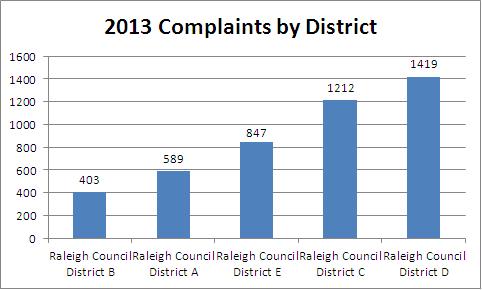
Raleigh resident Mark Turner, a former chairman of the East Citizens Advisory Council, uses the website often to report graffiti in his area.
“It’s something that if you let it grow, it really becomes a problem,” Turner said of his interest in the removal of graffiti. “I’m really proud that when people visit Raleigh, they say it’s a really clean city.”
An Uncertain Future
Buonpane said improvements to the SeeClickFix program are likely coming. The city has been seeking a way to integrate work-order software into SeeClickFix, providing better documentation and oversight.
There is no timetable for implementation of the work-order program at present.
“The integration (of a work-order system) will help, but it’s not going to solve everything,” he added.
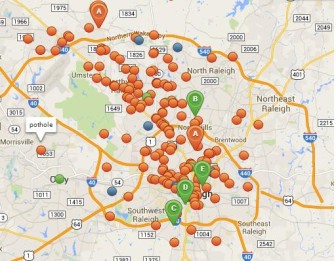
A map of current SeeClickFix complaints in Raleigh
Raleigh’s contract with SeeClickFix expires in the spring of 2015. Buonpane said the city may choose to take proposals from similar companies to “make sure we are getting a good price and that they are meeting our needs.”
Gaylord, the man who brought SeeClickFix to the Raleigh masses, has been pleased with the program’s success.
“(SeeClickFix has) been great to work with,” he said. “As they continue to upgrade their software and add new modules, we will continue to work with them.”
“Technology enables a whole new level of citizen engagement,” Gaylord said. “We need to give citizens a greater way to influence the way their government is run.”
